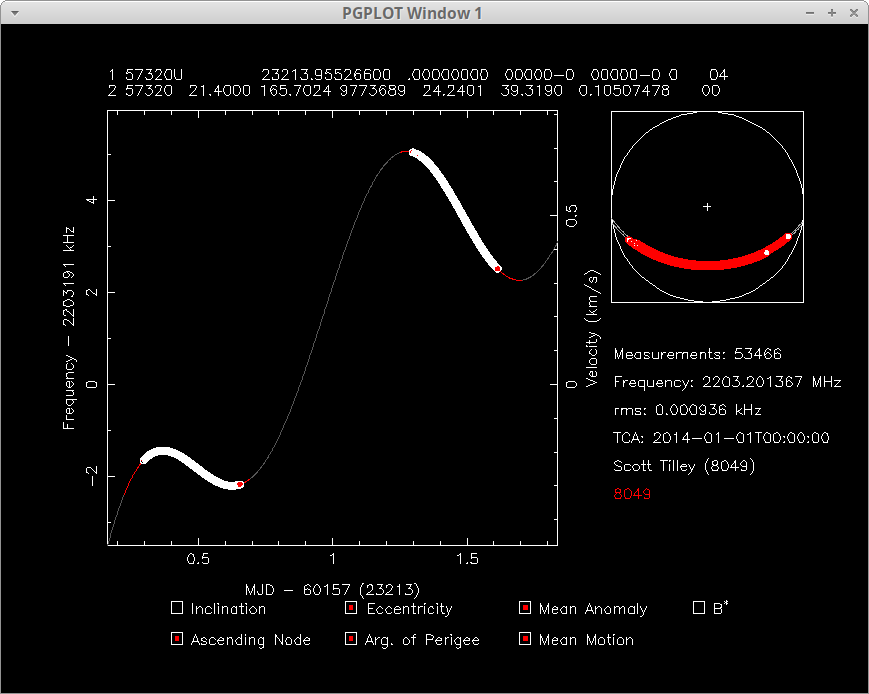Here's a summary of why I'm watching the #Meridian-M launch with interest.
Before the launch of Meridian 8, Meridian 3 stopped communication transponder activity and created a 'gap'. I called this the Meridian 3 gap. MORE...
Before the launch of Meridian 8, Meridian 3 stopped communication transponder activity and created a 'gap'. I called this the Meridian 3 gap. MORE...
https://twitter.com/coastal8049/status/1161140563611045889
Normally the Meridian constellation has 4 operational satellites and as you can see from the Doppler plot in this attached tweet from last year they are spaced so that there is always an active satellite over North American or and Russian apogees.
https://twitter.com/coastal8049/status/1122973918325690368
Meridian satellites launch into a Molniya orbit and then drift for about 10-14 days. The older satellites seemed to do this for less time and the new Meridian-M a little more. Once in the plane they desire they sync the orbit to 2 revs every sidereal day.
This plot, with software courtesy of @cgbassa, provides a look at key orbital elements of Meridian 8 just after launch. As you can see it changes it's orbit as expected to sync up in this case with Meridian 3's plane. Orbital data from @SpaceTrackOrg. 
https://twitter.com/coastal8049/status/1163239752943857665

@cgbassa @SpaceTrackOrg Just after launch TASS reported the successful insertion of Meridian 8 into orbit and that communications had been established. We see the orbital sync up in the elements and wait to see transponder activity after they commission the s/c... tass.com/science/1070982
@cgbassa @SpaceTrackOrg Early this year regular checks reveal Meridian 8 remains silent on all known radio bands they use. 278, 484, and 7500MHz. I ask @uhf_satcom to investigate C-band and finds a signal, likely the TT&C beacon for Meridian 8.
https://twitter.com/uhf_satcom/status/1219684132256714753
@cgbassa @SpaceTrackOrg @uhf_satcom So as we wait for Meridian 9 to be launched, we're really waiting to see what is going on with Meridian 8. As Meridian 9 seems destine for the orbital plane of Meridian 6 the mystery deepens further.
https://twitter.com/cgbassa/status/1220625983025315840
@cgbassa @SpaceTrackOrg @uhf_satcom There could be a number of perfectly reasonable explanations for Meridian 8's behaviour.
1) Prolonged commissioning of a new satellite type,
2) It doesn't have the same functional behaviour,
3) It has experienced some sore of technical glitch or failure.
1) Prolonged commissioning of a new satellite type,
2) It doesn't have the same functional behaviour,
3) It has experienced some sore of technical glitch or failure.
@cgbassa @SpaceTrackOrg @uhf_satcom One may ask what happened to Meridian 3? It appears to made some sort of major orbital change on or before October 31, 2019 when it changed it's mean motion and significantly affected it perigee and apogee altitudes. It's no longer 'in' the constellation. 

@cgbassa @SpaceTrackOrg @uhf_satcom So as of today this is the #Meridian constellation status:
Meridian 1 - non-operational,
M 2 - operational but not in the constellation due to launch failure,
M 3 - non-operational,
M 4 - operational,
M 5 - not in orbit,
M 6 & 7 - operational,
M 8 - unknown.
Meridian 1 - non-operational,
M 2 - operational but not in the constellation due to launch failure,
M 3 - non-operational,
M 4 - operational,
M 5 - not in orbit,
M 6 & 7 - operational,
M 8 - unknown.
• • •
Missing some Tweet in this thread? You can try to
force a refresh



















